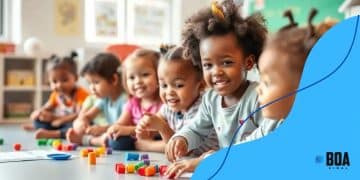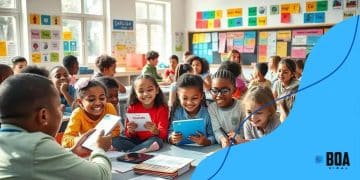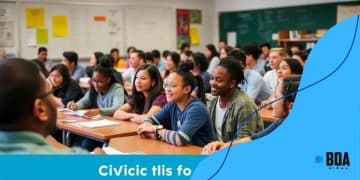Literacy improvement strategies 2025: Unleash potential
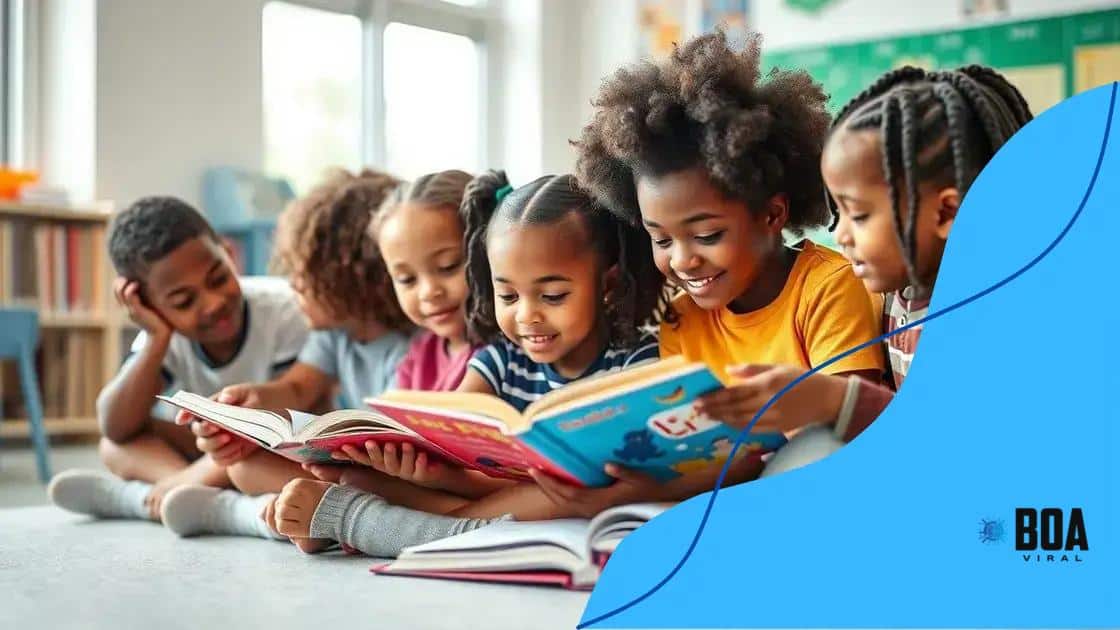
Literacy improvement strategies 2025 focus on integrating technology, engaging parents, and utilizing community resources to enhance student reading and writing skills effectively.
Literacy improvement strategies 2025 are reshaping how we approach reading and writing education. Have you ever wondered how new methods can unlock potential in students? This article explores innovative strategies that can transform learning.
Understanding literacy improvement strategies
Understanding literacy improvement strategies is crucial in today’s educational landscape. These strategies help educators and students thrive by enhancing reading and writing skills. By recognizing different approaches, we can create an effective learning environment.
The core components of literacy improvement
Effective literacy strategies focus on several key areas. It’s important to address each component to ensure comprehensive support for learners. These may include:
- Phonemic awareness: The ability to hear, identify, and manipulate individual sounds in spoken words.
- Vocabulary development: Introducing new words actively helps students build a rich language base.
- Fluency: Practicing reading smoothly and quickly promotes confidence and comprehension.
- Comprehension strategies: Teaching students how to understand, analyze, and respond to texts is essential.
By integrating these core components into daily lessons, teachers can significantly improve literacy skills. Continuous assessment and feedback are also vital. Regularly checking in on student progress allows for adjustments to be made. This ensures that all learners are supported according to their individual needs.
Integrating technology in literacy education
Another effective way to enhance literacy development is through technology integration. Digital tools can make learning engaging and accessible. For instance, using tablets and educational apps can provide interactive experiences that keep students interested.
Furthermore, online platforms can create communities where students read and discuss literature, inspiring a love for reading. These connections can deepen understanding and encourage collaboration among peers.
Utilizing technology not only helps with traditional literacy skills but also prepares students for a future where digital literacy is essential. It’s vital that educators embrace these tools in their teaching.
The role of technology in literacy enhancement
The role of technology in literacy enhancement has grown remarkably in recent years. With the advent of various digital tools, education now incorporates innovative methods to improve reading and writing skills. Leveraging these tools can make learning more engaging and effective for students.
Benefits of using technology in literacy education
There are numerous advantages to integrating technology in literacy programs. For instance, interactive apps can help students practice their skills in fun and engaging ways. Technology also allows for differentiated instruction, catering to diverse learning styles. Some of the key benefits include:
- Increased engagement: Students are often more motivated to learn when technology is involved.
- Immediate feedback: Digital tools can provide instant feedback, helping students learn from their mistakes in real-time.
- Access to diverse resources: Technology connects students to vast online libraries and educational platforms.
- Collaboration opportunities: Online forums and group projects can foster teamwork and communication among peers.
Combining traditional teaching methods with technological advancements creates a richer learning experience. For example, using e-books alongside physical books can enhance comprehension and make reading more accessible.
Another significant aspect of incorporating technology is promoting digital literacy. As students use various tools, they also learn to navigate the digital landscape responsibly. Understanding how to gather and evaluate information online prepares them for a future where digital skills are crucial.
Examples of effective technological tools
Many tools can effectively support literacy enhancement. Programs that utilize gamification or adaptive learning strategies have proven especially popular. Some examples include educational games and mobile apps that focus on phonics, vocabulary, and comprehension.
Moreover, integrating social media platforms in education encourages students to write and share their thoughts. Blogging, for instance, helps them express their ideas while also learning about audience engagement and self-publishing.
Engaging parents in literacy initiatives
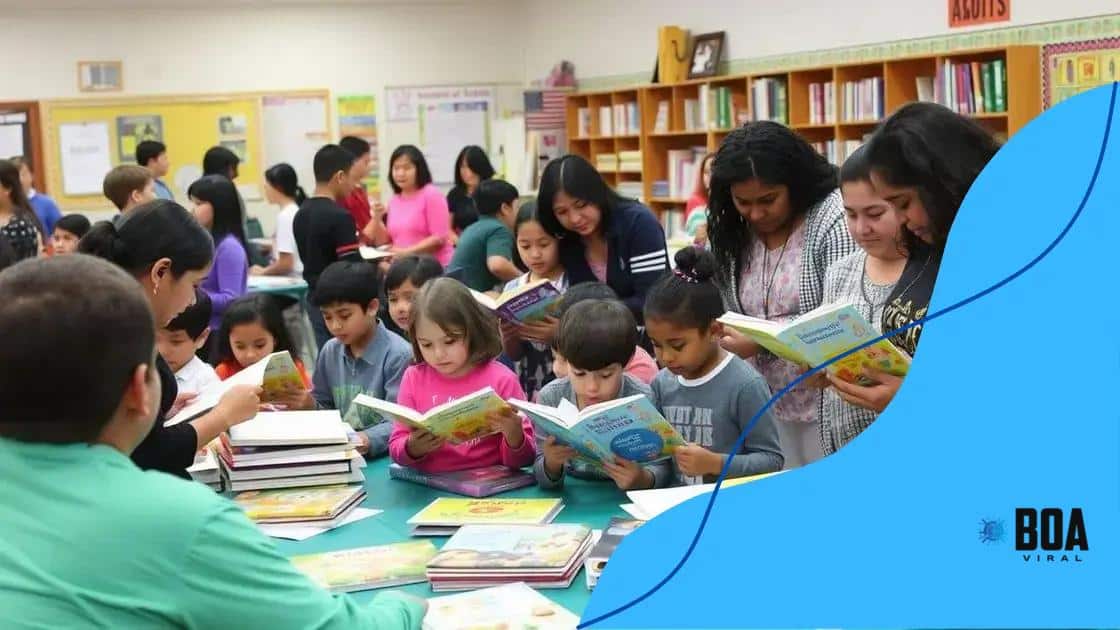
Engaging parents in literacy initiatives is vital for fostering a love of reading in children. When parents participate, they can support learning at home and reinforce skills taught at school. This involvement can create a culture of literacy that benefits everyone.
Ways to involve parents in literacy programs
There are various methods to encourage parent involvement in literacy activities. Schools can host events that invite families to engage with literacy in fun ways. Some effective strategies include:
- Literacy workshops: Organizing workshops that teach parents how to assist their children with reading.
- Reading nights: Hosting special evenings where families can come together to read and enjoy stories.
- Take-home resources: Providing parents with materials like books, worksheets, and activities that they can use at home.
- Online platforms: Creating online portals where parents can access resources and communicate with teachers about their child’s progress.
Creating a welcoming environment for parents is also essential. Schools should make it clear that parental involvement is valued and appreciated. Encouraging a partnership between teachers and parents can strengthen student literacy outcomes. When parents feel included, they are more likely to engage actively.
Moreover, recognizing the importance of diverse backgrounds is key. Schools should provide resources in multiple languages and adapt their strategies to meet the unique needs of each family. This will help all parents feel empowered to participate in their child’s literacy journey.
Communicating effectively with parents
Clear communication is crucial for engaging parents. Schools should regularly update parents about literacy initiatives and their child’s progress. Effective communication may involve newsletters, emails, or social media updates.
Additionally, making connections between what is happening in the classroom and what parents can do at home empowers families. Providing tips or suggestions for activities can help bridge the gap and keep parents informed and involved.
Best practices for teachers in 2025
Best practices for teachers in 2025 focus on adapting to the changing educational landscape. As technology advances, teachers must also evolve their methods to meet the needs of today’s learners. Embracing innovation while maintaining effective teaching strategies can significantly enhance student engagement and outcomes.
Incorporating technology into the classroom
Teachers should leverage technology to create interactive learning experiences. For example, using educational software and online resources can facilitate differentiated instruction. This allows educators to tailor lessons to suit individual learning styles and paces.
Some effective ways to incorporate technology include:
- Flipped classrooms: Students learn new content at home and engage in activities in class, promoting active learning.
- Interactive whiteboards: These tools allow teachers to present information in dynamic ways, encouraging student participation.
- Online collaboration tools: Platforms like Google Classroom enable students to collaborate on projects, enhancing teamwork skills.
- Virtual reality: Immersive experiences can transport students to historical sites or complex environments, enhancing their understanding.
Integrating these technologies can make lessons more engaging. However, it is essential for teachers to maintain a balance between tech use and personal interaction.
Fostering a supportive classroom environment
A supportive classroom is key to effective learning. Teachers should create an inclusive atmosphere where students feel safe to express themselves. Open communication and positive reinforcement encourage students to take risks in their learning.
Additionally, understanding the diverse backgrounds of students is vital for fostering inclusivity. Teachers can implement culturally responsive teaching methods that celebrate diversity, making every student feel valued.
Regular feedback is another best practice. Teachers should provide constructive feedback to guide student development. This helps learners understand their strengths and areas for improvement, allowing them to take charge of their education.
Professional development and collaboration
In 2025, ongoing professional development will be essential for teachers. Engaging in workshops, conferences, and peer collaboration can keep educators updated on the latest trends in teaching.
Moreover, collaboration among teachers can lead to richer educational experiences. Creating professional learning communities enables teachers to share insights and effective strategies. This culture of collaboration ultimately benefits students by enhancing the quality of instruction.
Community resources for literacy support
Community resources for literacy support play a vital role in helping individuals improve their reading and writing skills. Local organizations, libraries, and educational programs can provide essential services and materials. By utilizing these resources, families and students can access additional support outside of the classroom.
Types of community resources available
Various community resources exist to aid literacy development. Understanding these options can empower families to seek support actively. Some of these resources include:
- Public libraries: Libraries often offer free programs such as storytime for young children and reading clubs for older students, fostering a love of reading.
- Nonprofit organizations: Many nonprofits focus on literacy, providing tutoring services, materials, and workshops for both children and adults.
- Community centers: Local centers may host literacy events and workshops that focus on skill-building and promoting literacy in families.
- Adult education classes: Programs designed to help adults improve their literacy skills are essential for workforce development and personal growth.
Accessing these resources can significantly enhance literacy outcomes for individuals of all ages. Many organizations even offer services in multiple languages to support diverse communities, ensuring that everyone has the opportunity to improve their literacy.
Collaborating with local organizations
Building partnerships with local organizations can also benefit schools and families. Schools can collaborate with these groups to create tailored literacy programs that meet the needs of their students. By coordinating efforts, they can pool resources and strengthen community involvement.
For instance, a school may work with a local library to develop summer reading programs that encourage children to read during breaks. This type of partnership not only promotes literacy but also fosters a sense of community.
Additionally, hosting workshops in collaboration with local nonprofits can provide parents with tools and strategies to support their children’s literacy at home. Educating parents about resources helps create a robust support system that benefits students.
FAQ – Frequently Asked Questions about Literacy Improvement Strategies
What types of community resources can support literacy?
Community resources include public libraries, nonprofit organizations, community centers, and adult education classes that offer various literacy programs.
How can parents get involved in literacy initiatives?
Parents can participate by attending literacy workshops, engaging in reading nights, and utilizing take-home resources provided by schools.
What are some best practices for teachers to enhance literacy?
Best practices include incorporating technology into lessons, fostering a supportive classroom environment, and providing regular feedback to students.
Why is collaboration with local organizations important?
Collaboration allows schools to enhance literacy programs, share resources, and create a stronger community support network for learners.

